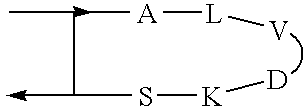Complementary peptide ligands generated from microbial genome sequences
a technology of microbial genome and peptide ligand, which is applied in the field of complementary peptide ligands generated from microbial genome sequences, can solve the problems of increasing the risk of resistance, the impact of poor socioeconomic conditions on the patient's treatment, and the inability to adapt to the characteristics of microorganisms,
- Summary
- Abstract
- Description
- Claims
- Application Information
AI Technical Summary
Benefits of technology
Problems solved by technology
Method used
Image
Examples
example 2
[0118] The complete genome of Mycoplasma genitalium which is 0.58 Mb in size and codes for an estimated 479 genes was screened for intermolecular peptides using the method described in patent application number GB 9927485.4, filed 19th November 1999. The gene, database accession number, its predicted interacting peptides and their position within the coding sequence of the gene are shown in the attached sequence listing: SEQ ID Nos. [1-754].
example 3
[0119] Derivation of `Child` Sequences from Parent Sequences
[0120] For each pair of `frames` of amino acids which are deemed a `hit` by the algorithm of the current invention includes derived pairs of composite `child` sequences of shorter frame lengths which automatically fulfil the same `complementary` relationship.
[0121] For example, there is a complementary frame of size 10 between genes (inter-molecular) MG002 and MG004 of mycoplasma genitalium.:
8 GENE1 GENE2 Sequence 1 Location Sequence 2 Location Score MG002 MG004 AYSILSDPNQ 47-56 LLSVGQNGIG 720-729 10
[0122] One embodiment of the invention covers the derivation of the following sequences at frame length of 5:
9 Se- quence GENE GENE2 1 Location Sequence 2 Location Score MG002 MG004 AYSIL 47-51 LLSVG 720-724 5 MG002 MG004 YSILS 48-52 LSVGQ 721-725 5 MG002 MG004 SILSD 49-53 SVGQN 722-726 5 MG002 MG004 ILSDP 50-54 VGQNG 723-727 5 MG002 MG004 LSDPN 51-55 GQNGI 724-728 5 MG002 MG004 SDPNQ 52-56 QNGIG 725-729 5
[0123] One embodiment o...
example 4
[0127] The complete genome of Mycoplasma genitalium which is 0.58 Mb in size and codes for
[0128] an estimated 479 genes was screened for intramolecular peptides using the method described in patent application number GB 9927485.4, filed 19th Nov. 1999. The gene, database accession number, peptide sequences and their position within the coding sequence of the gene are shown in the attached sequence listing: SEQ ID Nos. [755-804].
PUM
| Property | Measurement | Unit |
|---|---|---|
| Genome Size | aaaaa | aaaaa |
| size | aaaaa | aaaaa |
| size | aaaaa | aaaaa |
Abstract
Description
Claims
Application Information
 Login to View More
Login to View More - R&D
- Intellectual Property
- Life Sciences
- Materials
- Tech Scout
- Unparalleled Data Quality
- Higher Quality Content
- 60% Fewer Hallucinations
Browse by: Latest US Patents, China's latest patents, Technical Efficacy Thesaurus, Application Domain, Technology Topic, Popular Technical Reports.
© 2025 PatSnap. All rights reserved.Legal|Privacy policy|Modern Slavery Act Transparency Statement|Sitemap|About US| Contact US: help@patsnap.com



